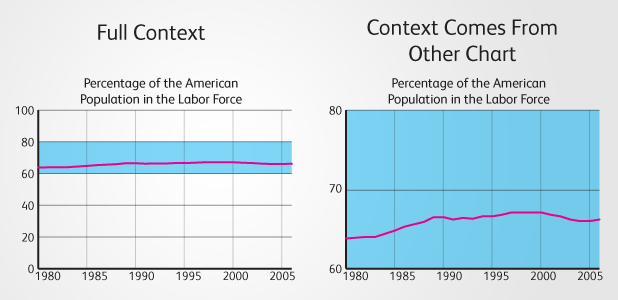The thing about telling stories through data is, sometimes you don’t know what the story is until you’ve visualized the data. And if the story isn’t what you expected, you may have to either: A. tell the “new” story as it is, or B. find another set of data and another story to tell. Unfortunately, sometimes the commissioner of the visualization may ask you to go with option C. tweak the visualization, or even the data, so it shows the story they want to tell. In the past, the team at Visual.ly has been asked to crop axes in order to exaggerate trends in a chart. The argument is that “as long as the axis is labeled correctly, it is okay”. It would be nice if this were true, but it is not. If we are to truly do visualization, then all of the information related to the chart should be visual. Properly labeled axes are always important, but they should never be part of the primary method of interpreting the data from a visualization. Often times, within a chart there are relationships that are shown between the blank spaces. The visual mark itself is not the only place that information is shown. One example of this is in a line chart showing percentages. (Data) 



The Importance of Being Earnest, or Showing Context in Data Visualization


Subscribe to our blog
Sign up to receive Rock Content blog posts
Related Posts
From Meta to Cara: Where Artists Reclaim Their Creative Freedom

Organic vs. Paid Marketing: Where to Invest?
May 8, 2023

After All, What Has Changed in Google’s Recipe Structured Data?
January 25, 2022


Order badass content with WriterAccess. Just as we do.
Find +15,000 skilled freelance writers, editors, content strategists, translators, designers and more for hire.
Want to receive more brilliant content like this for free?
Sign up to receive our content by email and be a member of the Rock Content Community!
Talk to an expert and enhance your company’s marketing results.
Rock Content offers solutions for producing high-quality content, increasing organic traffic, building interactive experiences, and improving conversions that will transform the outcomes of your company or agency. Let’s talk.

